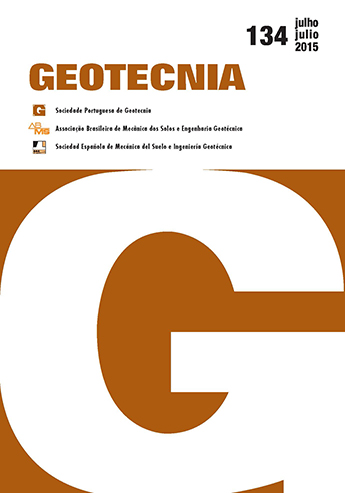Criteria for determining the cement content in soil-cement pavement layers
DOI:
https://doi.org/10.24849/j.geot.2015.134.07Keywords:
Technical criteria, Cement content, PavementAbstract
In sites with lack of aggregates and with soils that do not meet the technical criteria, or for building with soil a resistant layer, soil stabilization techniques can be applied. Among the materials employed in this type of process, cement is the most used since it provides greater technical and economic feasibility. This work will discuss the technical criteria to be applied and analysed to determine the optimum cement content to be incorporated into the soil for use of the mixture as pavement layer material. The criteria currently used are based only on values obtained from tests of compressive strength and durability by wetting and drying, which are not sufficient to analyse the behaviour of the stabilized material under the effect of local weathering.
Downloads
References
ABNT NBR 12023 (2012). Solo-Cimento – Ensaio de Compactação. Rio de Janeiro. 7 p. ABNT NBR 12253 (2012). Dosagem para camada de pavimento – Procedimento. Rio de Janeiro. 3 p.
ABNT NBR 13554 (2012). Ensaio de durabilidade por molhagem e secagem – Método de ensaio. Rio de Janeiro. 4 p.
ACI (1990). State-of-the-Art Report on Soil Cement, ACI Committee 230. ACI Materials Journal, Vol. 87, No. 4, pp. 395-417.
Alcântara, M.A.M. (1995). Estabilização química dos solos para fins rodoviários: técnicas disponíveis e estudo de caso dirigido à estabilização solo-cal de três solos de Ilha Solteira-SP. Dissertação (Mestrado em Geotecnia). Universidade Federal de Viçosa. 91 p.
ASTM D 559-03 (2003). Standard test methods for wetting and drying compacted soil-cement mixtures.
ASTM D 560-03 (2003). Standard test methods for freezing and thawing compacted soil-cement mixtures.
ASTM D 1633-00 (2003). Standard test methods for compressive strength of molded soil-cement cylinders. 4 p.
ATIC-Associação Técnica da Indústria do Cimento (1993). Estradas de Solo-Cimento. Boletim Técnico N° 13.
Branco, F.; Pereira, P.; Santos, L.P. (2008). Pavimentos Rodoviários. Coimbra: Almedina.
Caltabiano, M.A.; Rawlings, R.E. (1992). Treatment of reflection cracks in Queensland. 7th International Conference on Asphalt Pavements, Nottingham, England.
De Beer, M. (1989). Aspects of erodibility of lightly cementitious materials. Research Report DPVT 39, Roads and Transport Technology, CSIR, South Africa.
Epps, J.A.; Dunlap, W.A.; Gallaway, B.M. (1971). Basis for the development of a soil stabilization index system. USAF Technical Report, AFWL-TR-70-176, Air Force Weapons Laboratory, Kirtland AFB, NM.
Feuerharmel, M.R. (2000). Comportamento de solos reforçados com fibras de polipropileno. Dissertação (Mestrado em Engenharia Civil) – Programa de Pós-graduação em Engenharia Civil, Universidade Federal do Rio Grande do Sul, Porto Alegre. 152 f.
Foppa, D. (2005). Análise de variáveis-chave no controle da resistência mecânica dos solos artifi cial - mente cimentados. Dissertação (Mestrado em Engenharia Civil) – Programa de Pós-graduação em Engenharia Civil, Universidade Federal do Rio Grande do Sul, Porto Alegre. 146 f.
George, K.P. (1972). Mechanism of shrinkage cracking in soil-cement bases. Highway Research Record, v. 442, pp. 1-21.
Guedes, S.B. (2013). Estudo do comportamento mecânico de um solo-cimento microrreforçado com fibras sintéticas para uso como revestimento primário em estradas não-pavimentadas. Tese (Doutorado em Engenharia Civil) – Programa de Pós-Graduação em Engenharia Civil, Universidade Federal de Pernambuco, Recife. 515 f.
Guthrie, W.S.; Scullion, T. (2000). Assessing aggregate strength and frost susceptibility characteristics with the TST. Paper presented at the Texas ASCE meeting, El Paso, TX.
Hitek Consultants (1998). Minimizing cracking in soil cement for improved performance. Technical Memorandum, prepared by Hitek Engineering Consultants Inc. for PCA, Oxford, MS.
Ingles, O.G.; Metcalf, J.B. (1972). Soil Stabilization: Principles and Practice. New York - Toronto, 374 p.
Kuhlman, R.H. (1994). Cracking in soil cement - cause, effect, control. Concrete International, pp. 56-59.
Lima, D.C.; Bueno, B.S.; Silva, C.H.C. (1993). Estabilização dos Solos II: Técnicas e Aplicações a Solos da Microrregião de Viçosa. Viçosa: UFV. 32 p.
Litzka, J.; Haslehner, W. (1995). Cold in-place recycling on low volume roads in Austria. Proceedings of the Sixth International Conference on Low Volume Roads, Minnesota, June.
McCallister, L.D.; Petry, T.M. (1991). Physical property changes in a lime-treated expansive clay caused by leaching, Transportation Research Record, 1295, pp. 37-44.
Norling, L.T. (1973). Minimizing reflective cracks in soil-cement pavements: a status report of laboratory studies and field practices. Highway Research Record 442, HRB, Washington D.C.
Pereira, R.S. (2005). Viabilidade técnica do emprego de resíduos da indústria de celulose para construção de estradas florestais. Tese (Doutorado em Ciência Florestal) – Programa de Pós-graduação em Ciência Florestal, Universidade Federal de Viçosa, Minas Gerais. 329 f.
Portland Cement Association. (1960). Subgrades, Sub-Bases and Shoulders for Concrete Pavement. Skokie. 5 f.
Samson, L.R. (1986). A study of the precision limits of wet/dry brushing durability test for cement-stabilized materials. Technical Report RP/26, NITRR, CSIR, South Africa.
Scullion, T.; Sebesta, S.; Harris, J.P.; Syed, I. (2005). Evaluating the performance of soil-cement and cement-modified soil for pavements: a laboratory investigation. Illinois: Portland Cement Association. 142 p.
Scullion, T.; Saarenketo, T. (1997). Using suction and dielectric measurements as performance indicators for aggregate base materials, Transportation Research Record, 1577, pp. 37-44.
Scullion, T.; Harris, P. (1998). Forensic evaluation of three failed cement treated base pavements, Transportation Research Record, 1611, pp. 10-18.
Senço, W. (2001). Manual de Técnicas de Pavimentação. 1. ed. São Paulo: PINI. v. 2.
Syed, I. Scullion, T. (1998a). Performance indicator for moisture susceptible stabilized base material in pavements. American Society of Civil Engineers, Texas Section Meeting, USA.
Syed, I.; Scullion, T. (1998b). In-place engineering properties of recycled and stabilized pavement layers. Report 3930-S, Texas Transportation Institute, Texas A&M University, College Station, TX.
Syed, I. (2000). Moisture movement in cement-stabilized base materials. Ph.D. Thesis, Texas A&M University, College Station, TX.
Van Wijk, A.J.; Lovell, C.W. (1986). Prediction of Subbase Erosion Caused by Pavement Pumping. Transportation Research Record No. 1099, USA.
Williams, R.I.T. (1986). Cement Treated Bases: Materials, Design and Construction, Elsevier Publishers, Ltd.
Wimsatt, A. (1998). TxDOT Fort Worth District Pavement Design Engineer, Private




